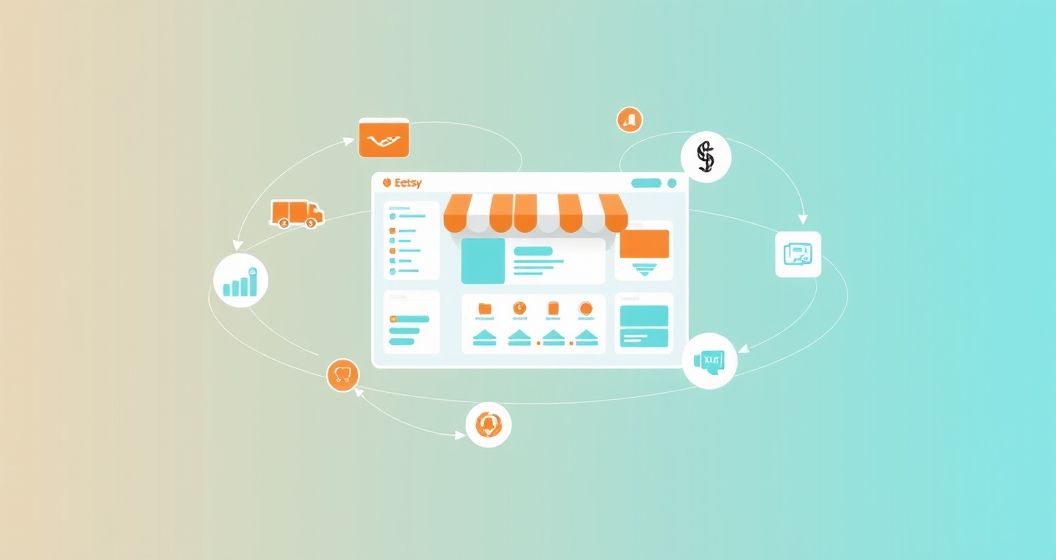In the dynamic world of online retail, Etsy stands out as a unique marketplace for handmade, vintage, and creative goods. For sellers aiming to scale their operations, merely listing products is often not enough. Strategic Etsy integrations become indispensable tools for automating workflows, managing inventory, streamlining shipping, and enhancing overall business efficiency. These powerful connections between Etsy and other software platforms enable sellers to centralize data, reduce manual tasks, and focus more on creativity and customer engagement, ultimately fostering sustainable growth and a more organized approach to e-commerce.
Understanding Etsy Integrations for E-commerce Growth
Etsy integrations refer to the process of connecting your Etsy shop with third-party applications and services. These connections allow data to flow seamlessly between your Etsy store and other essential business tools, such as accounting software, inventory management systems, and shipping solutions. The primary goal of these integrations is to automate repetitive tasks, minimize errors, and provide a holistic view of your business operations. This strategic approach empowers Etsy sellers to manage their shops more effectively, regardless of their business size or sales volume.
The importance of integrating Etsy with external platforms lies in its ability to transform a manual, time-consuming process into an automated, efficient system. Without integrations, sellers often find themselves manually updating spreadsheets, copying order details, and switching between multiple platforms, which can lead to mistakes and wasted time. By embracing various Etsy integrations, sellers can unlock significant operational advantages, enhancing their capacity to handle increased sales and complex inventory demands without feeling overwhelmed by administrative burdens.
Streamlining Operations: Key Types of Etsy Integrations
Effective management of an Etsy shop often necessitates the use of various external tools. Integrating these tools with your Etsy store creates a cohesive ecosystem that improves efficiency across the board. Understanding the different categories of Etsy integrations helps sellers identify the solutions most relevant to their specific business needs and growth objectives, ensuring every aspect of their e-commerce venture is optimized for performance and customer satisfaction. The right blend of integrations can significantly enhance a seller’s competitive edge.
Inventory Management Systems: Syncing Stock Across Platforms
For Etsy sellers who also sell on other platforms, managing inventory can be a significant challenge. Inventory management integrations automatically synchronize stock levels across all your sales channels, including your Etsy shop. This prevents overselling and ensures that product availability is always accurate, providing a consistent experience for customers. These systems often offer centralized dashboards where you can track inventory movement, monitor product performance, and manage variations, making inventory control a far more manageable task.
Shipping and Fulfillment Solutions: Enhancing Delivery Efficiency
Shipping integrations connect your Etsy store directly with various shipping carriers and fulfillment services. These tools automate the process of generating shipping labels, calculating postage costs, and providing tracking information to customers. By integrating these solutions, sellers can save time on manual data entry, reduce shipping errors, and often access discounted shipping rates. Efficient shipping contributes significantly to customer satisfaction, as timely and transparent delivery is a key factor in positive buyer experiences and repeat business for an Etsy shop.
Accounting Software Integrations: Simplifying Financial Tracking
Keeping accurate financial records is crucial for any business, and Etsy shops are no exception. Accounting software integrations automatically import your Etsy sales data, expenses, and transaction fees directly into your chosen accounting platform. This automation simplifies bookkeeping, tax preparation, and financial analysis, saving countless hours of manual data entry. With a clear financial overview, sellers can make informed decisions about pricing, profitability, and future investments, ensuring the long-term financial health of their Etsy business.
Print-on-Demand (POD) Services: Expanding Product Offerings
Print-on-demand integrations allow Etsy sellers to offer custom-designed products without holding any physical inventory. When a customer places an order for a POD item in your Etsy shop, the integration automatically sends the order details to the POD service provider, who then prints, packages, and ships the product directly to the customer. This model significantly reduces overhead costs and inventory risks, enabling sellers to experiment with new product lines and scale their offerings effortlessly, a major advantage for creative entrepreneurs.
Multi-Channel Selling Platforms: Expanding Reach Beyond Etsy
Many Etsy sellers choose to expand their presence beyond the marketplace by establishing their own standalone e-commerce websites or selling on other platforms. Multi-channel integrations facilitate this expansion by allowing sellers to manage product listings, orders, and customer data from a single centralized dashboard. This approach simplifies the complexities of selling across multiple channels, ensuring consistency in product information and pricing, while significantly broadening the potential customer base for an Etsy business.
Marketing and Customer Relationship Management (CRM) Tools
Integrating Etsy with marketing and CRM tools can dramatically enhance how sellers connect with their audience. These integrations enable automated email campaigns based on customer purchase history, segmenting customers for targeted promotions, and tracking customer interactions effectively. By nurturing customer relationships and delivering personalized marketing messages, Etsy sellers can foster loyalty, encourage repeat purchases, and build a strong, recognizable brand presence that resonates with their ideal customers.
Choosing the Right Etsy Integration: A Strategic Approach
Selecting the most suitable Etsy integrations requires careful consideration of your specific business needs, current operational challenges, and future growth aspirations. Evaluate each potential integration based on its core functionalities, ease of setup, and compatibility with your existing workflow. Prioritize integrations that address your most pressing pain points, whether it’s inventory management, shipping efficiency, or financial tracking. A phased approach, starting with one or two critical integrations, can help ensure a smoother transition and allow you to assess their impact before committing to a broader suite of tools for your Etsy shop.
Maximizing Profitability: The Impact of Efficient Etsy Integrations
The strategic implementation of Etsy integrations directly contributes to increased profitability by optimizing various aspects of your business. By automating tasks, sellers can reduce labor costs and reallocate valuable time to product creation, marketing, and customer service. Integrations minimize errors, preventing costly returns and customer dissatisfaction. Furthermore, streamlined operations allow for higher sales volumes without a proportional increase in administrative overhead. This efficiency empowers Etsy sellers to scale their businesses more effectively, leading to enhanced revenue streams and a stronger financial foundation.
Overcoming Challenges with Etsy Integrations: Best Practices
While Etsy integrations offer numerous benefits, sellers might encounter challenges during setup or ongoing management. Common issues include data synchronization discrepancies, initial setup complexities, or selecting integrations that don’t fully meet business needs. To mitigate these, always conduct thorough research, choose reputable integration providers, and ensure clear understanding of how data flows between platforms. Regularly review and test your integrations to confirm they are functioning correctly, and stay informed about updates to both Etsy and the integrated applications. Proactive management ensures smooth, uninterrupted operation for your Etsy business.
Empowering Your Etsy Business with Strategic Integrations
Etsy integrations are not just conveniences; they are essential growth engines for any ambitious seller. By strategically connecting your shop with the right tools, you can transform manual processes into automated workflows, gain deeper insights into your business performance, and significantly improve customer satisfaction. These integrations free up your time to focus on what you do best: creating unique products and building a thriving brand. Embrace the power of integration to unlock the full potential of your Etsy business, ensuring efficiency, scalability, and sustained success in the competitive e-commerce landscape.






